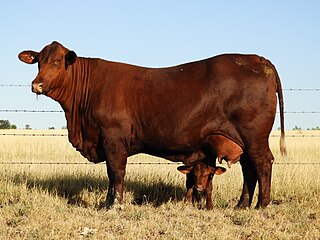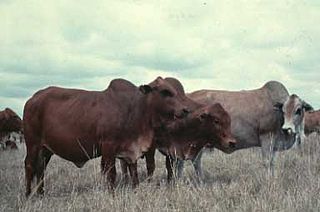
The Canchim is a breed of beef cattle developed in Central Brazil by crossing European Charolais cattle with Indubrazil cattle already kept in Brazil where Asian Zebu type cattle are best suited to the tropical conditions. When compared with Zebu bulls, Canchim bulls produce the same number of calves, but heavier and of superior quality. Compared to European breeds, the Canchim bull produces calves with the same weight but in larger numbers. The fast-growing progeny, from crossbred zebu cows with Canchim bulls, can be slaughtered at 18 months old from feedlots after weaning, up to 24 months old from feedlots after grazing and at 30 months from grazing on the range.

The zebu, sometimes known in the plural as indicine cattle, Camel cow or humped cattle, is a species or subspecies of domestic cattle originating in South Asia. Zebu, like many Sanga cattle breeds, differs from taurine cattle by a fatty hump on their shoulders, a large dewlap, and sometimes drooping ears. They are well adapted to withstanding high temperatures and are farmed throughout the tropics.

Bovines comprise a diverse group of 10 genera of medium to large-sized ungulates, including cattle, bison, African buffalo, water buffalos, and the four-horned and spiral-horned antelopes. The members of this group are classified into loose tribes rather than formal subgroups, as the evolutionary relationships within the groups are still uncertain. General characteristics include cloven hooves and usually at least one of the sexes of a species having true horns. The largest extant bovine is the gaur.

Bos is a genus of bovines, which includes, among others, wild and domestic cattle.

Madura Island is an Indonesian island off the northeastern coast of Java. The island comprises an area of approximately 4,436.77 square kilometres (1,713.05 sq mi). Administratively, Madura is part of the province of East Java. It is separated from Java by the narrow Madura Strait. The administered area had a density of 755.6 people per km2 in mid-2023, while the main island had a somewhat higher figure of 840 per km2.

The Highland is a Scottish breed of rustic cattle. It originated in the Scottish Highlands and the Western Islands of Scotland and has long horns and a long shaggy coat. It is a hardy breed, able to withstand the intemperate conditions in the region. The first herd-book dates from 1885; two types – a smaller island type, usually black, and a larger mainland type, usually dun – were registered as a single breed. It is reared primarily for beef, and has been exported to several other countries.

The Heck or Munich-Berlin is a German breed or type of domestic cattle. It was bred in the 1920s by Heinz and Lutz Heck in an attempt to breed back the extinct aurochs. Controversy revolves around methodology and success of the programme. There are considerable differences between Heck cattle and the aurochs in build, height, and body proportions. Furthermore, there are other cattle breeds which resemble their wild ancestors at least as much as Heck cattle.

The Brahman is an American breed of zebuine-taurine hybrid beef cattle. It was bred in the United States from 1885 using cattle originating in India, imported at various times from the United Kingdom, India, and Brazil. These were mainly Gir, Guzerá and Nelore stock, with some Indu-Brasil, Krishna Valley and Ongole. The Brahman has a high tolerance of heat, sunlight and humidity, and good resistance to parasites. It has been exported to many countries, particularly in the tropics; in Australia it is the most numerous breed of cattle. It has been used in the creation of numerous taurine-indicine hybrids, some of which – such as the Brangus and Brahmousin – are established as separate breeds.

The banteng, also known as tembadau, is a species of wild bovine found in Southeast Asia.

Madurese, Madurans, Madurites or Madurace are one of the Javan ethnic groups native to the Indonesian island of Madura in Java Sea, off the northeastern coast of Java. They speak their own native Madurese, sharing a common history, traditions, and cultural identity. Nationwide, the Madurese are the third-largest ethnic group in Indonesia, and one of the well-known Indonesian national dishes, Satay, is attributed to the Madurese as part of their culinary heritage.

The Murray Grey is an Australian breed of polled beef cattle. It originated between 1905 and 1917 in the upper Murray River valley, on the border between New South Wales and Victoria. It is similar in appearance to the Aberdeen Angus, from which it largely derives, but is grey, silver or dun in colour.

A bovid hybrid is the hybrid offspring of members of two different species of the bovid family. There are 143 extant species of bovid, and the widespread domestication of several species has led to an interest in hybridisation for the purpose of encouraging traits useful to humans, and to preserve declining populations. Bovid hybrids may occur naturally through undirected interbreeding, traditional pastoral practices, or may be the result of modern interventions, sometimes bringing together species from different parts of the world.

The Santa Gertrudis is an American breed of beef cattle. It is a taurine-indicine hybrid breed, descended from both zebu and European cattle. It was bred in the early twentieth century in Texas, and received official recognition in 1940. It has been exported to many countries including Australia, Brazil and South Africa, and has contributed to the development of a number of modern breeds, among them the Barzona and the Droughtmaster.

The Bali cattle, also known as Balinese cattle, Bali banteng, Indonesian cattle, or most generally, the domestic banteng are a domesticated species of bovine which originated from the banteng. Bali cattle are an important source of meat and are used for plowing. They are thought to have originated in Bali.

The Red Sindhi is a dairy breed of zebuine cattle. It is believed to originate in western Sindh and in the Las Bela area of Balochistan, now in Pakistan. It is widely kept in Pakistan, where in 2006 there were approximately 3000000 head; there are small numbers in India and in Bangladesh. Other names include Las Bela, Malir and Sindhi.

Boran cattle are a popular Zebu beef breed in eastern Africa.
Jamaica Hope is a dairy breed of cattle originating from Hope Farm in Jamaica.

Cattle are large, domesticated, bovid ungulates widely kept as livestock. They are prominent modern members of the subfamily Bovinae and the most widespread species of the genus Bos. Mature female cattle are called cows and mature male cattle are bulls. Young female cattle are called heifers, young male cattle are oxen or bullocks, and castrated male cattle are known as steers.

The Punganur is an Indian breed of small zebuine cattle. It is found in the hill country of Chitoor District, in Andhra Pradesh in southern India, and is among the smallest of all zebu breeds.


















